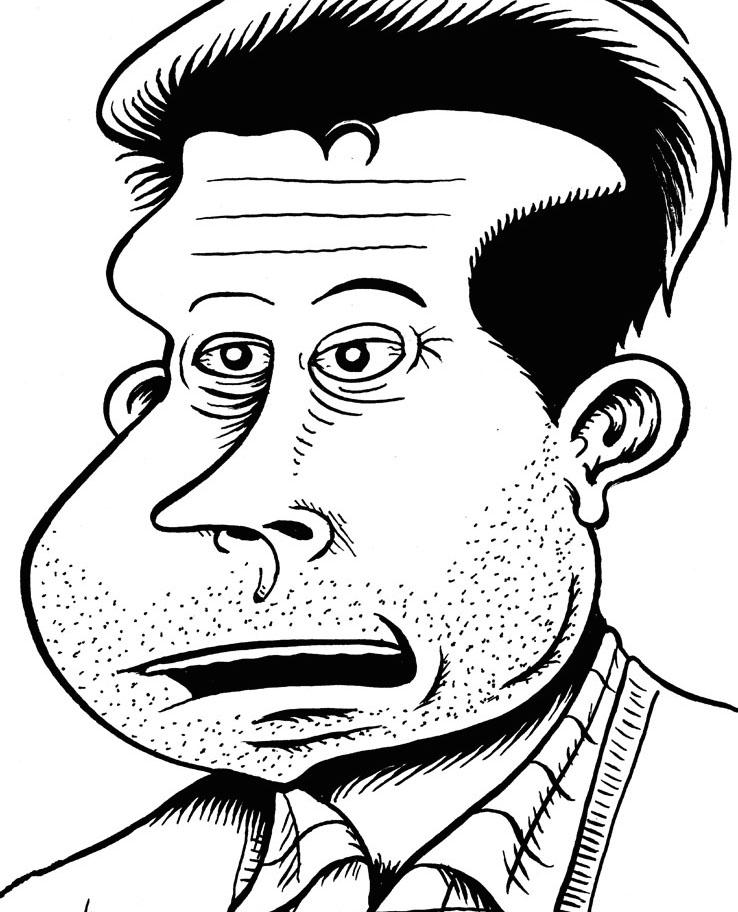
This year, I’m listening again to selections from the archive of long-form interviews I conducted on the public radio program The Marketplace of Ideas and podcast Notebook on Cities and Culture between 2007 and 2015.
On trips to the library growing up, I’d make right for the comics section — around Dewey Decimal 741, if memory serves. The selection didn’t change often, so I took out the same books over and over again: collections of early 20th-century strips like Krazy Kat and Popeye, which in the bland context of the 1990s seemed almost rebelliously eccentric; The Big Book of Urban Legends; plenty of Zippy the Pinhead anthologies; and more of often than most, The Adventures of Junior and Other Losers by a certain Peter Bagge. It offered everything I wanted at age eleven or twelve: clearly the work of one man alone (then as now, I don’t spent much time on teams), it had a highly distinctive art style, stories and dialogue that seemed “real” (as opposed to the words and deeds of funny animals and superheroes), and — most essential of all — absolutely nothing in it seemed aimed at, or rather down to, kids.
Only later did I find out that Bagge, a longtime resident of the greater Seattle area where I myself lived, was a comic-artist icon — or at least he’d long held iconic status in the field of “alternative comics,” a movement to which Seattle back then represented, or had recently represented, a Mecca. He’d made his name with the series Hate, which throughout the 1990s chronicled the life of a young slacker (to use the zeitgeist word of the time) named Buddy Bradley as he bounced between cities, between scams and quasi-legitimate jobs, and between frightening girlfriends and very frightening girlfriends. I first binged on it with a phonebook-thick collection of Hate‘s first few years purchased on a weeklong school trip to Ashland for the Oregon Shakespeare Festival. The store, More Fun, had a slogan fourteen-year-old me certainly couldn’t resist: “Comic books for grownups.”
And though my own growing up has in few or no ways resembled Buddy’s, episodes of his thoroughly Gen-Xer life — some of which I’ve read through five, ten, fifteen times — still come vividly to my mind on a near-daily basis. On the way down to California, moving before college (not, for better or for worse, a chapter of Buddy’s still-rigorous education), I stopped in on More Fun again to catch up on Hate. Around that same time, Bagge began contributing, in comics form, to the libertarian magazine Reason, a development that delighted me: somehow I felt relieved that he didn’t hold the Standard Pacific Northwest Liberal suite of political views, even though my own might lean slightly closer to those of the SPNL than those of Reason. And Bagge himself has, over these past fourteen years of Reason work, revealed himself as hardly an ideologue — again to my relief.
Given all Hate and the rest of Bagge’s oeuvre has undeniably done to shape my very psyche, I knew I had to find an excuse to talk to him as soon as I got into the interviewing game. The first opportunity came in 2008, when a book about him and his work came out — not a book by him, but close enough for me — and the second came the next year, on the publication of his first bound collection of Reason pieces. The third took over half a decade to line up, but it made perfect sense, since I’d ended The Marketplace of Ideas and started the more place-oriented Notebook on Cities and Culture. Recording another interview with him in Seattle when I next happened to be there, I then used it to promote the Kickstarter fund drive for Notebook on Cities and Culture‘s Seattle-oriented sixth season. In the event, the money came up way short, but I did have what seemed, at least to me, a pretty ideal guest with whom to end the show.
EPILOGUE: I went back to to More Fun on a West Coast road trip taken between ending Notebook on Cities and Culture and before moving to Seoul. Naturally I stocked up again on Bagge material once again, making the transaction with the very same proprietor who’s stood behind the counter on every single one of my five-ish-yearly visits — a little grayer than the first time, sure, but then I don’t exactly look like a teenager anymore myself.